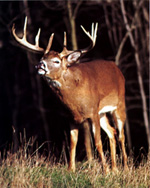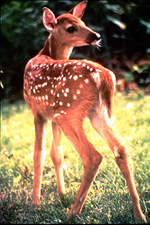|

Mammals of Pennsylvania and New Jersey

|
|
|
Deer
Background Information
The white-tailed deer can be found throughout the United
States, except for desert regions, parts of southern Canada,
and northern areas of South America. They are widely hunted
for their meat and fur.
They are the most common hoofed animal in North America. Early morning and
evening are the best times to see them. Deer have well developed senses of
seeing, smelling, and hearing. Besides people, the greatest danger to deer
is the mountain lion. However, we do not have mountain lions in Pennsylvania
or New Jersey.
Physical
Features
Deer are
known for their reddish brown fur. They often have a large
white patch of fur on their necks. The underside of deer
is often white. Deer also have a white marking under their
tails. When running, the tail flies into the air showing
the white tail. Another name for a deer’s tail is a
flag. |


|
From
head to tail, deer can be 4 to 6 feet long. They are about
3 feet tall, with the female a little shorter. Their flags
can be as long as 1 foot. Male deer can weigh more than
300 pounds. A female deer can weigh as much as 250 pounds.
Adult
male deer have antlers that divide like two
tree branches. They have points or prongs growing from each
“branch.” Male deer shed, or lose, their antlers
each winter. They grow back antlers before the mating season.
|
Life
Cycle
Deer mate in late summer or early fall. A male deer, called
a buck, will fight for the right to mate
with female deer, called a doe. They use
their antlers as weapons. After mating, the male deer will
leave the female deer. After about 8 months, the female deer
will give birth to one or two baby deer.
The babies
are called fawns. They have white spots on
their fur. They can walk from birth, but they prefer to hide
in the cover provided by their home. Fawns will move only
when the mother comes to feed them. Fawns will leave their
mothers after 1 to 2 years.
Sometimes
deer live alone, other times they live in small groups.
In harsh, cold winters, they will gather together for body
heat. Deer live 10 years in the wild and 20 years in zoos. |
 |
Habitat
Deer
live in many places in the wild. They do not have a place
called home such as a nest, burrow, or den. Their homes can
be in the forests, brush areas, woodland patches, swamps,
or even in suburban areas. They move from
place to place looking for food.
Diet
Deer
are herbivores. That means they feed from
many kinds of plants. Their food is made up of tender roots,
grasses, twigs, leaves, fruit, and flowers from many types
of shrubs. They will eat small branches of trees during harsh
winters. Being such large animals, they have to eat large
amounts of food to survive.
|
|
© Dr.
Randall Pellow, 2005 |